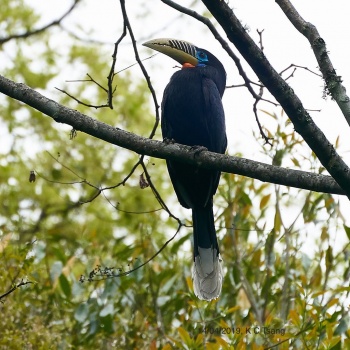- Aceros nipalensis
Identification
90–100 cm (35½-39½ in); a very large hornbill
- Pale yellow bill with black stripes
- Blue skin around eye
Male
- Rufous head, neck and underparts
- Black back and wings
Female
- Brownish-black overall plumage
Distribution
Himalayan foothils of Bhutan, north-east India, Burma, southern Yunnan (China) and south-east Tibet, north and western Thailand, northern Laos and northwest Vietnam.
Extinct in Nepal and in northwest Thailand, rare and declining in most parts of its range.
Taxonomy
This is a monotypic species.[1]
Habitat
Mature, dense, evergreen and broadleaved forest, mainly in the hills up to altitudes of 1,800 metres.
Threatened due to habitat loss.
Behaviour
Diet
Their diet consists mostly of fruit, such as mangoes and figs.
Breeding
Monogamous. They excavate a nest hole in a large tee. The female seals herself within, laying two eggs during April (Bhutan); the male feeding her and the chicks through a slit. When the chicks are ready to fledge after about 125 days, the female breaks out with the young leaving soon after.
References
- Clements, J. F., T. S. Schulenberg, M. J. Iliff, D. Roberson, T. A. Fredericks, B. L. Sullivan, and C. L. Wood. 2018. The eBird/Clements checklist of birds of the world: v2018. Downloaded from http://www.birds.cornell.edu/clementschecklist/download/
- Del Hoyo, J, A Elliot, and J Sargatal, eds. 2001. Handbook of the Birds of the World. Volume 6: Mousebirds to Hornbills. Barcelona: Lynx Edicions. ISBN 978-8487334306
- Handbook of the Birds of the World Alive (retrieved May 2019)
Recommended Citation
- BirdForum Opus contributors. (2025) Rufous-necked Hornbill. In: BirdForum, the forum for wild birds and birding. Retrieved 13 May 2025 from https://www.birdforum.net/opus/Rufous-necked_Hornbill






